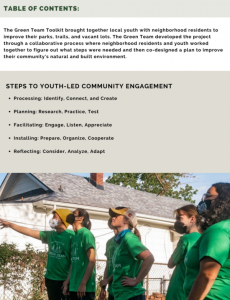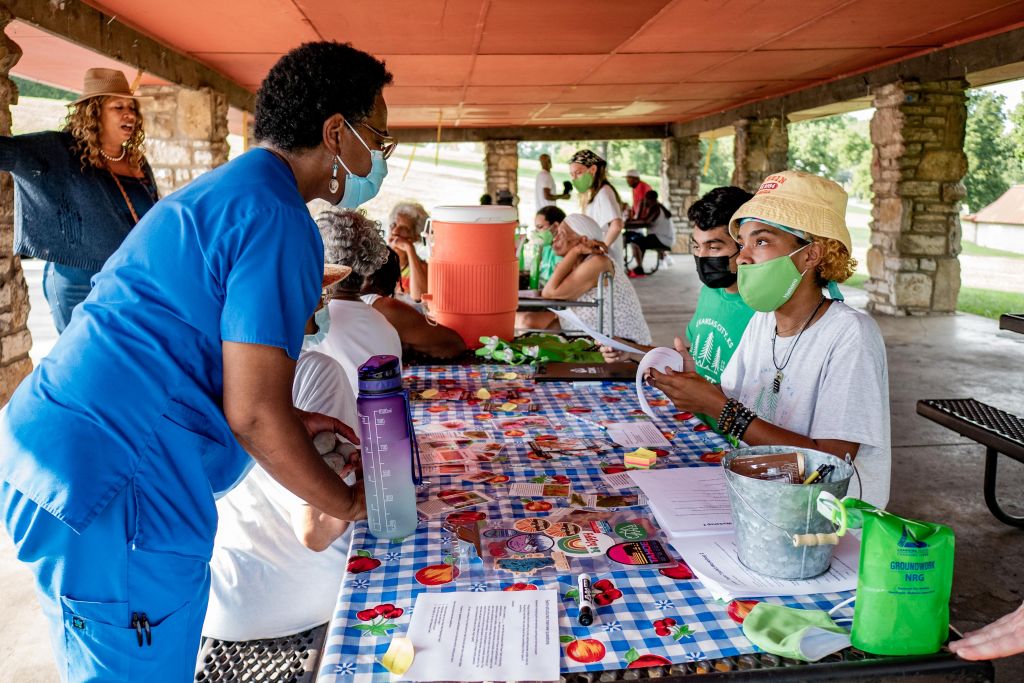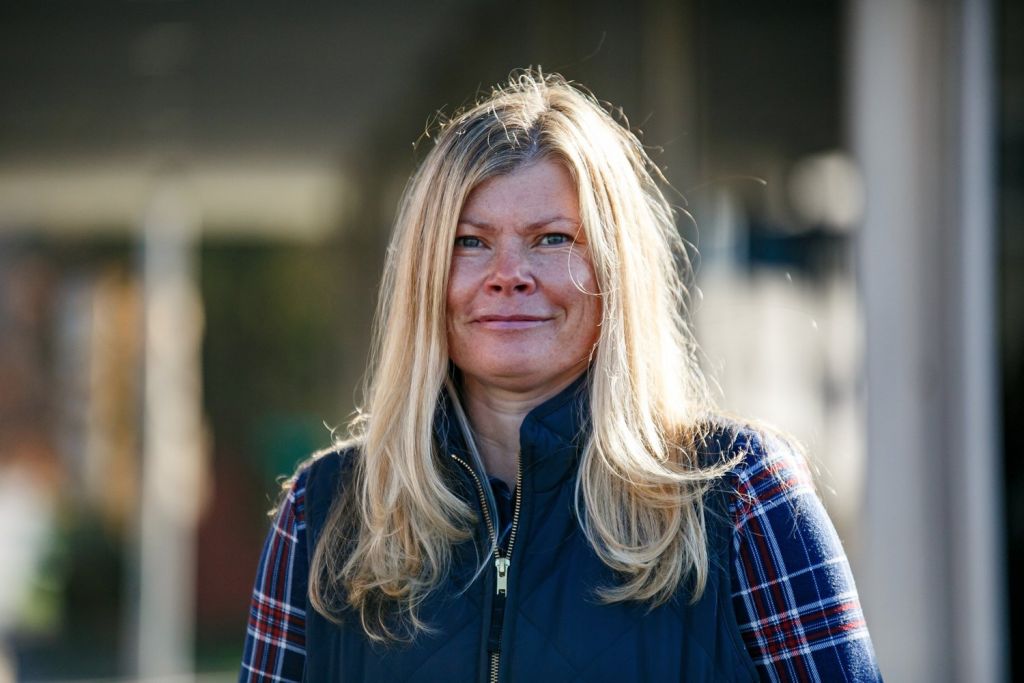Brenda Brinkhous-Hatch
Green Team Program Coordinator
Groundwork Northeast Revitalization Group
Brenda Brinkhous-Hatch has been planning and facilitating youth development opportunities throughout her career and continues on that path in her current role as Green Team Coordinator for Groundwork Northeast Revitalization Group (NRG). Brenda has worked collaboratively on building curriculum and programming partnerships with public schools and community organizations from California to Missouri. She loves being outdoors and through her work with the Green Team, she has been able to share that enthusiasm with youth crew members through the implementation of environmental conservation and historical preservation projects in northeast Kansas City, Kansas.
Brenda is currently a member of the Urban Waters Learning Network Water Equity and Climate Resilience Collaborative.
This interview was edited for length and clarity.
Tell me about your role at Groundwork NRG.
I started on the team in September of 2020 as the Green Team Coordinator. Since our organization was so new, there hadn’t been a Green Team program yet. So when I came on, I worked really closely with Rachel Jefferson, our Executive Director, to develop our curriculum. We had known that we wanted to bring youth on the team and make them part time paid employees rather than volunteers. We also wanted to incorporate job training opportunities within the programming. When we were building out the curriculum, we looked for hands-on projects that we might do in the community, including green revitalization of vacant lots, water testing, soil testing, conservation, and green infrastructure.
We built that out first, and then I started recruiting with the local schools. We got some youth interested and were up and running. From last spring to this year, I’ve been working with the same kids. They’re youth that live within our northeast Kansas City, Kansas (KCK) community. We have six and Green Team members, 17 and 18 year olds, that are all part time paid employees. They are on our website, they are official.
We are currently working on three green revitalization projects and on history catching projects. The youth are learning about the history of northeast KCK, and we are interviewing residents to capture oral history that is going to be built into a heritage trail map. I feel like my role is one of the best on the team because I get to work with these amazing youth. We are always doing something different from week to week.
How did you, personally, come into this work?
I’ve had a late-stage career change. I started out as a visual arts educator, working mostly with elementary school kids in the public school system…as an educator for family programs at art museums…and at a contemporary museum here in KCK. Then I really started getting into urban farming on the side. So I left the museum world and started volunteering with some really amazing women farmers in North Kansas City where I live.
Being outside and getting dirty, it is something that I just really love. A job with the University of Missouri Extension in their 4-H program offered me the opportunity to get some additional schooling. I got a certificate in Agroforestry through the University of Missouri and then started getting an interest in urban farming, urban biodiversity, and green infrastructure.
How do you integrate climate resilience into your work with the Green Team?

Green Team youth prepared a toolkit guide for community engagement.
Everything that we do, we do with the community. We’re learning together. We’ve been learning about green infrastructure… native and invasive plants… the impacts of stormwater and flooding and the extreme heat in urban landscapes. Green infrastructure can offset (those impacts). As a team we’ve been developing how we engage the community and how we do the actual work.
One of the first things that the green team started working on is the green team toolkit [for community engagement and education]. I’ll generally sit in on one of [the neighborhood association’s] monthly meetings. We then facilitate a community engagement workshop. And in that workshop, the green team starts to educate the residents about green infrastructure, rain gardens, and the kinds of things we could put on the vacant lot in their community. The green team also educates the residents about how green infrastructure can make their neighborhoods more climate resilient.
The residents also give us feedback, (such as) what they would like to see on that lot, what kind of flowers and plants they love. They give us feedback on what they like and what they want, because it’s in their community, and we want them to use (the open space).
As we have built on these lots, we’re there weekly maintaining it, making sure it looks great and doesn’t become overgrown. In that act, the neighbors see us again and again and again. They start coming over and saying hi. They’ll start working with us sometimes. They’ll even bring tools to help make our work easier if they see us struggling. At the end of last year, we hosted a neighborhood party. We had planted over 100 native flowers on this lot; everything had finally gone to seed. It was a sort of a seed sharing party. Neighbors came with little baggies and walked around pulling and popping seeds that they loved. Some of them even brought us seeds to incorporate next year. It’s become this pretty great relationship.

Youth facilitate the Green Team toolkit with residents at a neighborhood gathering. Photo: Brenda Brinkhous-Hatch
What keeps you motivated in this work?
Relationships. (My) relationships with the Green Team youth keep me motivated because of their energy. Every week is different. The planning and organizing that goes into the work that we do keeps me moving forward. It’s the relationships that I have with my team at Groundwork…and the relationships that I’ve been able to develop with the residents. They will text me if they have some ideas or concerns about a lot we’re working on. They fill us up with so much love and gratitude about putting in this hard work to help make their neighborhoods not just more beautiful but to make them more resilient in the face of extreme weather that everybody’s experiencing now.
What do you foresee for the Green Team youth?
I would like to see these youth continue to give back to the community; and, I would love to see even more youth on the Green Team. I would love to see them moving forward, not necessarily deciding to make a career out of conservation or environmental stewardship, but to have an awareness of how our climate is changing and how we protect the communities that we love…to be able to look at the community to problem-solve solutions for things that they’re seeing and…build a strong bond with the community that they’re living in to affect change.
Do you have any words of wisdom or advice to others who are doing this work?
It’s persistence. I’ve definitely had to step outside of my box quite a few times and to not be afraid of challenges. There’s a lot of preconceived ideas about what teenagers are like now…like teenagers these days are always on the screen or whatever. And they’re wrong. I think [it’s important] to keep a really open mind about what someone is capable of and what they can do. Because they continue to surprise me on a weekly basis. They are not afraid of hard work, physical or otherwise. It is great and incredibly fulfilling working side by side with youth doing this kind of work.


